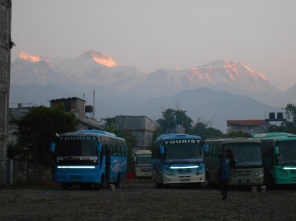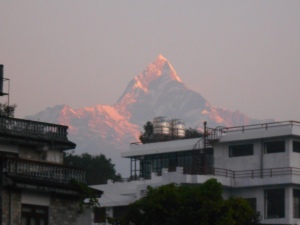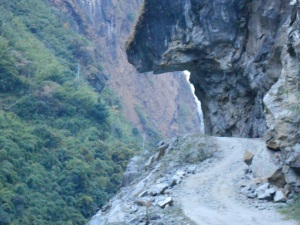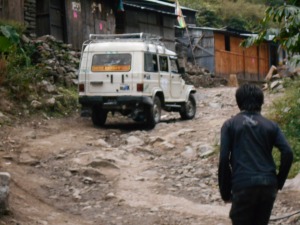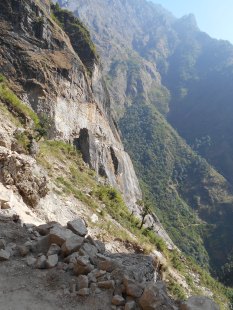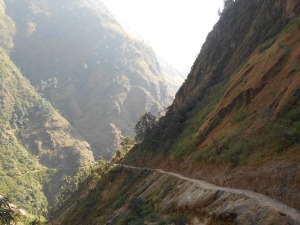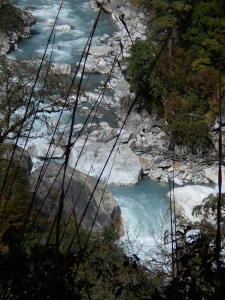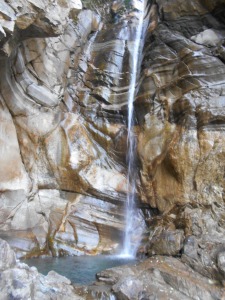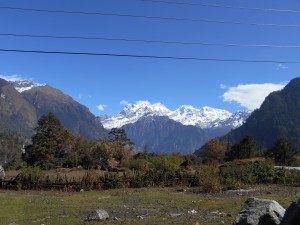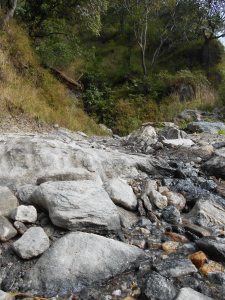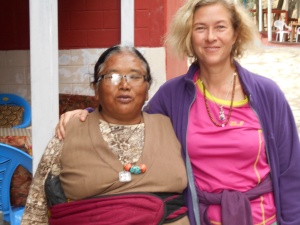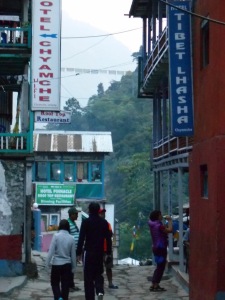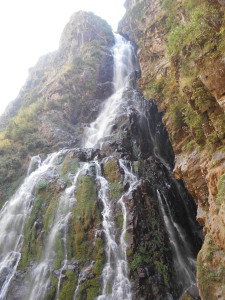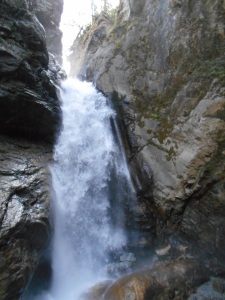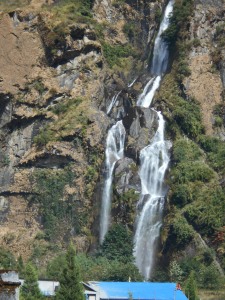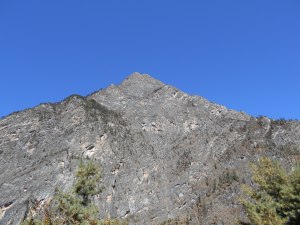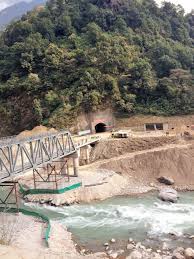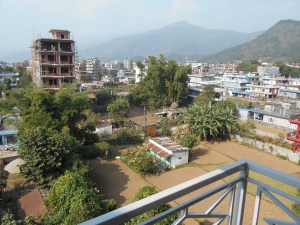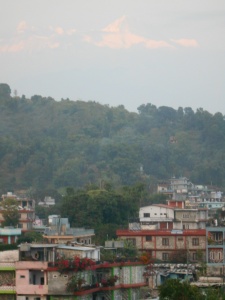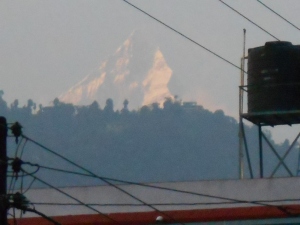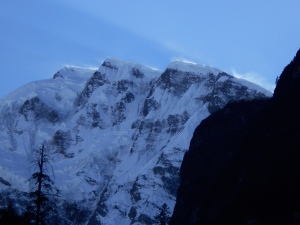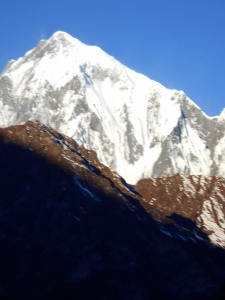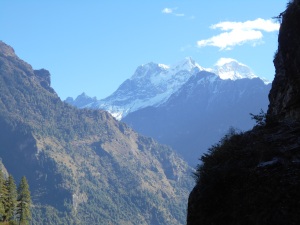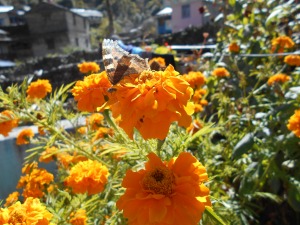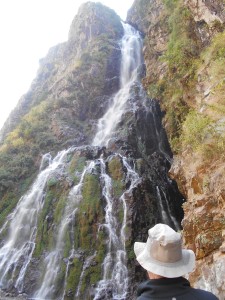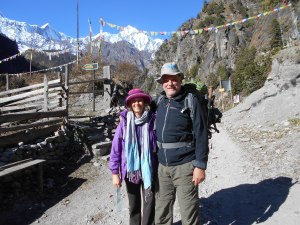As Paul and I crossed the threshold from being urban dwellers to Himalayan trekkers, we had no idea where this path would lead.
In the quest to be guided by the ascended masters and our own intuition, we stepped off the local bus in Besishahar, Nepal, naive to what lay ahead. We placed our packs on our backs and set forth to locate the Eastern Annapurna Circuit Trailhead.
At the same time, two other Swiss trekkers inquired whether or not we wanted to share a jeep for part of the journey. We looked at the map and said, “That could be a good place to start the trek”. After 15 more minutes of deliberations, we agreed to ride with them thus eliminating 2 days if we had gone by foot. Our adventure was about to begin.
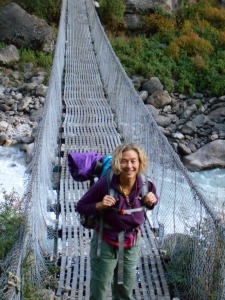 What I did not realize was that we would be stuck in a tank-like vehicle for 5 hours bouncing violently the entire way. What I did know was that we had a loose plan, a topo map and 12 days. Within the first hour I realized that the jeep ride was the first of many initiations along the way. The fact that I did not suffer from whiplash or other injuries was a bonus.
What I did not realize was that we would be stuck in a tank-like vehicle for 5 hours bouncing violently the entire way. What I did know was that we had a loose plan, a topo map and 12 days. Within the first hour I realized that the jeep ride was the first of many initiations along the way. The fact that I did not suffer from whiplash or other injuries was a bonus.
At a brief stop, I checked in with Paul to see how he was doing. He said, “I’m keeping the consciousness and focus of the tires staying on the road.” At that point, I knew that my own tension was reflected in his statement. My own concentration sometimes said out loud, “Turn the wheels, turn the wheels!” As my eyes glanced 1,000 feet ~ 300 meters ~ down at the sheer rock cliff below.
So far the “Government Highway” has not installed guardrails. Multiple times an image flashed before my eyes … the jeep plunging to the bottom of the aqua white glacier water. The mega-river forced her way through the canyon with such raw power. She carved it smooth during eons of time, mama gaia’s endless beauty of light and form, dancing their unity in diversity.
I was caught between sheer panic and utter joy and bliss, beholding the majesty of our mother-earth.
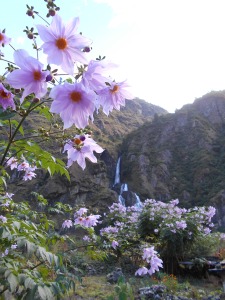 At the halfway point, I suggested that we could walk the rest of the way. My spine from top to bottom had already received about 50 adjustments. At one point I looked at the Swiss woman beside me and stated, “This is not a road, it is a river ~ bed.”
At the halfway point, I suggested that we could walk the rest of the way. My spine from top to bottom had already received about 50 adjustments. At one point I looked at the Swiss woman beside me and stated, “This is not a road, it is a river ~ bed.”
She simply smiled. Was I the only one who was ridiculously nervous?
Minutes later, the Nepalese man next to me stated the obvious, “This is a dangerous road. Last year a jeep and bus went over the edge and many people died.”
I was not the only one fearing for my life.
Obviously we made it to our planned destination. Jostled, breathless and exhausted, Paul and me were greeted by our Tibetan Grandmother and owner of the first teahouse.
Chyamche became the starting point of our trek. [For those of you who have ascended this trail and completed the whole circuit, I applaud you. It takes determination, physical endurance, courage and willingness to go beyond all your limitations at once]. We walked 4-6 hours a day for 9 days. For five days we climbed 6,100 feet ~ 1850 meters up and down. We beheld the grandeur of earth, her dozens of waterfalls and tributary rivers that flow towards India.
Paul and I slept on beds that were more comfortable than the ones in Pokhara hotels. We ate food that was grown on the land in the villages. We ate vegetable curry every night testing each cook’s [male and female] creative variations. Then we traded tips with other trekkers as to which places had the best culinary delights. At one point while eating delicate, simmering apple pie, under the benevolent gaze of the most vertical place in the world, I was struck both at the melting of my soul and the revelation that Annapurna Circuit needs more loving care from the entire globe.
We observed China’s foothold in the guise of building hydropower facilities, for free. Nothing is free. I marveled at the vastness of the construction project underway, tearing down the jungles, making some villages a concrete wasteland. They even created a tunnel for the diversion of the river around the dam until the construction is complete. In light of my heart’s expansion and spiral consciousness, I can’t judge the Nepalese for this needed expansion of infrastructure. Electrical power is now provided to some of the most remote mountainous regions in the world.
I did ask one 27-year-old man what he thought of the jeeps, “good” or “not so good?” He responded by saying, “Not so good.” I could see him remembering a time before the road and before the jeeps invaded his mountain people’s Peace. Every step forward changes the topography of the situation at hand. Every country ought to have the benefit of modern progress. Otherwise a teenage woman in the most remote region could not walk an hour from her friend’s community to her village while talking on her I-Phone the entire way home.
The Nepal tourist industry is uplifting many from poverty. On one hand I am pleased that the economy is booming for many Nepalese. The first time I visited Nepal was in 1983 (32 years ago) there where a total of 10 guest houses in Pokhara, a small village next to the lake. I was 16 at that time. The population then was about 14,000,000 and now it is 29,860,686. Today, I can book 137 hotels in Pokhara online through Agoda.com. This view from our balcony, I could not have envisioned in 1983.
My heart cried as I waited for breakfast at a lakeside restaurant in Pokhara. I could not see the closest foothills or the breathtaking 26,000-foot mountains of the great Himalaya’s. They were shrouded behind a brown haze that I refer to as smog mixed with moisture from the lake.
In sheer denial, many of the Nepalese in the area call it fog or haze from the water of the lake.
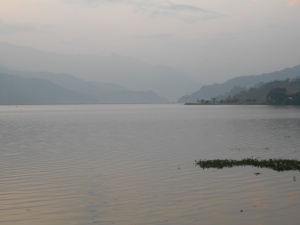 Most trash in Nepal is torched and we are all breathing plastic particulates into our lungs in the densely populated areas. It will take a commitment from all of us who love nature and want to keep it pristine for future generations.
Most trash in Nepal is torched and we are all breathing plastic particulates into our lungs in the densely populated areas. It will take a commitment from all of us who love nature and want to keep it pristine for future generations.
A week in the Himalayas changes everything. I want the earth to renew Herself. I want to live along side Her in a peaceful synergy that illuminates my will to embody and experience the exquisiteness of this now moment. I want to simply allow the oxygen of the place we all call home to enter all my cells without concern for my health.
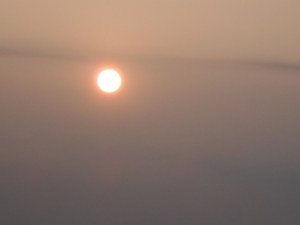 Ironically the sunset will be a shade of red/orange/brown caused by the distortion of all the burning in the area — a muted version of its normal brilliance. After hiking untold miles up, we finally breathed 100% pure oxygen and drank perfect water. In this moment, I reflect on my own impact on the mountain, upon each village and each human being that I encountered on that trail. All along pondering, the eons of time when these Himalayan villages had no outside visitors. I wonder about how it is for them to have jeeps stir the dust and disturb the silence and the symphony of the forest?
Ironically the sunset will be a shade of red/orange/brown caused by the distortion of all the burning in the area — a muted version of its normal brilliance. After hiking untold miles up, we finally breathed 100% pure oxygen and drank perfect water. In this moment, I reflect on my own impact on the mountain, upon each village and each human being that I encountered on that trail. All along pondering, the eons of time when these Himalayan villages had no outside visitors. I wonder about how it is for them to have jeeps stir the dust and disturb the silence and the symphony of the forest?
If we, as trekkers, want to adore this spirit expanding opportunity in nature then let us assist Nepal to get on track with sustainable growth and a reliant clear map of how to achieve these goals. These kind of actions will keep Nepal’s part of the planet intact for all humans, who dare, be embraced by mother-Gaia, in her glory, free of trash (plastics) and open sewages.
P.S. Mother Earth needs our support. As a mountain trekker, I want to see a shift from a degraded environment of trash/plastics on the trail and sewage running into the river below; to a clean, organized structure of reducing Trekkers impact throughout Nepal. If we want to continue to have these trails and guest-houses available for our kids and grandkids then we need to find a way to lighten the load of westerners visiting in mass to see the highest land in the world.
There are so many ways you can be involved:
• Create awareness with friends planning trips to Nepal. The environment in Nepal is in desperate need of concerted, global attention.
• The next time you plan to trek, take out extra rubbish.
• Suggest to your Government officials and or NGO’s, that Nepal is in need of a compressive plan for waste management and sewage treatment infrastructure.
• You can investigate organizations like the following to know the facts: http://www.smallearth.org.np/uploaded/File/urbanwater_small.pdf
These small acts can provide a way to empower these people to leap into the 21st century with dignity and not destroy their natural assets along the way. ~ Reese Jula
